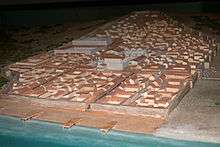Baelo Claudia
 The ruins of Baelo Claudia lie along the beach of Bolonia. | |
 Shown within Spain | |
| Location | Bolonia, Province of Cádiz, Andalusia, Spain |
|---|---|
| Coordinates | 36°05′23″N 05°46′29″W / 36.08972°N 5.77472°WCoordinates: 36°05′23″N 05°46′29″W / 36.08972°N 5.77472°W |
| Type | Settlement |
| History | |
| Founded | End of the 2nd century BC |
| Abandoned | 6th century AD |
Baelo Claudia is the name of an ancient Roman town, located 22 kilometres (14 mi) outside of Tarifa, near the village of Bolonia, in southern Spain. Lying on the shores of the Strait of Gibraltar, the town was originally a fishing village and trade link when it was settled some 2,000 years ago. Although prosperous at the time of Emperor Claudius, it went into a decline hastened by earthquakes and was abandoned by the 6th century.
History

Baelo Claudia is situated on the northern shore of the Strait of Gibraltar. The town was founded in the end of the 2nd century BC as a result of trade with North Africa (it was a major port for Tangier, in Mauretania Tingitana, for example). It is possible that Baelo Claudia had some functions of governmental administration, but tuna fishing, salting, and the production of garum were the primary sources of wealth.[1] The city was eventually successful enough to be granted the title of municipium by Emperor Claudius.
The life of the inhabitants reached its greatest splendor during the 1st century BC and the 2nd century AD. In the middle of the 2nd century, however, the town declined, probably as a result of a major earthquake which wiped out a large part.[1] In addition to such natural disasters, by the 3rd century, the town was beset by hordes of pirates, both Germanic and Barbary. Although it experienced a slight renaissance later in the century, by the 6th century, the town had been abandoned.
Excavations have revealed the most comprehensive remains of a Roman town in the whole of the Iberian Peninsula, with extremely interesting monuments such as the basilica, theatre, market, and the temple of Isis. The spectacular setting in El Estrecho Natural Park allows the visitor to see the coast of Morocco. A modern Visitor Centre showcases many artefacts and has a comprehensive introduction to the site. It also offers parking, shade, toilets, a shop and good views of the sea. Admission is free to citizens of the European Economic Area on production of an ID card.[2]
The archeological site
The archeological site of Baelo Claudia preserves the most representative elements of the typical Roman city. There is a circular protective wall, the main gate, administrative buildings like the curia (local senate), the public archive, the forum, the judicial building, a temple to the Egyptian goddess Isis, as well as temples to Juno, Jupiter, and Minerva. Each god has its own individual temple, instead of one temple dedicated to them collectively; the only other Roman town believed to have a similar arrangement is Sbeitla in Tunisia. In addition, there are remnants of stores, a market, baths, and a theater.
Three aqueducts supplied the town with water. There are signs of an industrial zone with the remains of streets, installations for the production of garum, aqueducts, and a sewer system. No other site in the Iberian Peninsula affords such a complete vision of the Roman urban experience. This is the site's main interest to modern visitors, and it can be seen via an impressive path that circles the town.

Sources
- Sillières, Pierre (1995). Baelo Claudia, une cité romaine de Bétique. Madrid.
See also
References
- 1 2 "Bolonia – Baelo Claudia". Andalucia.com. Retrieved 2009-10-07.
- ↑ "General Information – Services and Installations" (in Spanish). Archived from the original on 30 May 2010. Retrieved 2010-05-09.
External links
| Wikimedia Commons has media related to Baelo Claudia. |



